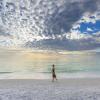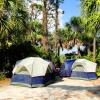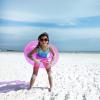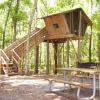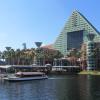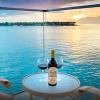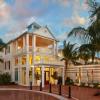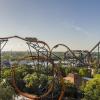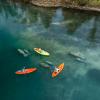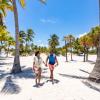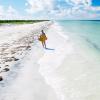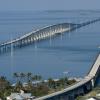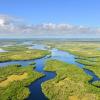By Leanora Minai
Your itinerary for fun on Florida’s Space Coast probably includes an unforgettable rocket launch that draws your eyes to the sky, but as you plan your adventures, you’ve got to try a guided bioluminescence tour by kayak or paddleboard in the dark of night.
It’s a captivating liquid light show. During certain times of the year, the surfaces of Mosquito Lagoon, Banana River, and Indian River Lagoon come alive with a blue-green glow when marine species such as mullet, manatees, and dolphins – and humans – encounter blooming algae, emitting light across the water.
A bioluminescence tour on the Space Coast is:
- a chance to observe one of the coolest natural phenomenon – “light produced by chemical reactions within a living organism” – that has captured the attention of people for centuries, including Benjamin Franklin;
- a rare “bucket list” opportunity to see marine animals in a new light, while gliding peacefully aboard a kayak or paddleboard.
Here’s a planner for your bioluminescence adventure – from best times to go to what to bring to a list of outfitters to book your tour on the Space Coast.
WHEN TO GO
Of all planning considerations, picking the best time for a tour is paramount. Peak bioluminescence season falls between July and September, and tour organizers say the best time of month to experience the shimmering glow beneath the warm water surface is during or within a few days of a New Moon. The darker the night, the better. You’ll also want to check the weather forecast for your tour area before booking to avoid inclement weather, an important consideration during Florida’s rainy season.
SELECTING A TOUR OUTFITTER
Florida's Space Coast Office of Tourism lists at least 11 tour operators that offer bioluminescence excursions at a range of durations and price points. From sunset to nighttime tours, in a kayak or atop a higher-up vista from a stand-up paddleboard, trips provided by outfitters on the Space Coast include an array of options to experience the glittering sea life. Every operator and every tour is different, so take the time to search the offerings to choose what options fit you or your family. Do you need a three-person kayak for a child? Do you prefer a clear-bottom kayak? Choices abound.
GETTING TO THE SPACE COAST
The Space Coast is 45 minutes east of Orlando, and three airports service the area, including Melbourne Orlando International Airport (MLB), which is on the Space Coast. Cocoa Beach, a destination for bioluminescence tours on the Banana River Lagoon, is within a 60-mile drive of Orlando area attractions such as Disney World, Sea World, and Universal Studios. If you’re traveling by car, use apps such as Google Maps or Waze to guide you to your outfitter, or get a basic overview of driving routes to Cocoa Beach here. Whatever outfitter you choose, allow plenty of time for travel and finding the meeting spot; arrive early so you can ask any questions – and apply bug spray before you launch.
TRAVEL PLANNING TIPS
For visitors driving to the Space Coast for a bioluminescence tour, consider staying overnight after your excursion ends. Nighttime tours typically begin after sunset, so by the time you’re off the water and on the road, it could be 11 p.m. or after, which, if headed to Orlando from Cocoa Beach, makes for a late drive and not quite the nightcap you may desire after a meditative time on the water. So, make your trip an overnight. On the day of the outing, check-in to your accommodations, relax or see a sight, then enjoy a carefree bioluminescence experience. The next day, eat a delicious breakfast and/or take in another activity before departing.
FIRST TIME PADDLING? NO WORRIES
No experience is necessary. Tour guides go over the basics of how to paddle a kayak or standup paddleboard. They also supply life vests. When you make your reservation, you can inquire about a single, tandem, or three-person kayak or paddleboard.
RESTROOMS
Some meeting spots or launch sites may not have a restroom so it’s a good idea to ask in advance when you book the tour.
WHAT TO EXPECT ON A BIOLUMINESCENCE TOUR
When I arrived on-site for my group eco kayak tour with Fin Expeditions on Cocoa Beach, our guide was waiting by a shoreline picnic table, ready to orient us by map and beam of a flashlight to the Banana River, a 31-mile-long lagoon between Cape Canaveral and Merritt Island in Brevard County, one of the rare places in the world to witness the phenomenon of bioluminescence. The brackish water of the lagoon – up to 4-feet in depth – is home to manatees, dolphins, stingrays, and other marine life.
An air of mystery and adventure sparked the moment we arrived at the launch site when we traded the well-lit, air-conditioned comfort of our car cabin for the dark of night and the unpredictable forces of nature, including a light drizzle that began falling just as we approached the picnic table.
We arrived early, and standing in the dark near the water’s edge waiting for other group participants to arrive was enough to get my blood pumping even before we set foot in the kayaks. Some people shared they were scared about being on the water at night and were nervous about what we might encounter. I was not nervous yet, just eager to get out there and see the glowing light show.
Getting in the boats required putting our feet in the water and navigating through some mangrove branches without being able to see very well, but the whole group was brave, and I felt we accomplished a lot just by being there.
Our first few paddle strokes revealed the first glimpses of the bioluminescence we had hoped for — each dip of the paddle ignited a soft blue-green glowing trail in the water.
Within a few minutes, we heard a scream, the sound of laughter and splashing. One of the couples had accidentally tipped over and found themselves afloat in the water, and trying to get back in their capsized boat they, like our paddles, created a wake of blue-green color in the water with their motion.
As we got on our way, our guide led us to some remote areas of the lagoon — places likely to have even less light and even more going on underwater so we could see the full magic of what we came for.
We encountered dolphins, comb jellies and schools of mullet that darted and jumped, creating fast-moving streaks of light, like lightning, underneath and all around us. I felt flashbacks to middle school science class as our guide explained how the microscopic organisms, called phytoplankton, were responsible for lighting up the water when they are touched — by a fish, a kayak paddle, a hand or foot, or anything else that might enter the water where they are living, which, in the summer months in the Banana River Lagoon, can be everywhere.
While the glittering light show was captivating, there were times later in our tour when our group just sat still in our boats, or quietly and slowly paddled under the moon, following the curve of the mangroves and canals. In those quiet moments, the sounds of the night creatures took center stage, and I was humbled and grateful we were able to be visitors in their habitat. The water continued lighting up under our boats, and I dipped my hand in and made glowing ripples as I let drippy droplets fall from my fingers back into the water, smiling as the summer breeze and shifting current helped us drift with little effort. I took that moment to tilt my head back and look in awe at the star-filled sky. The iridescent lights in the water that we had come for eventually became just one part of the whole experience.
I’ve traveled to Costa Rica, Thailand, Morocco, and other destinations, but this nighttime paddle ranks among my top five outdoor experiences. It was a mesmerizing and magical 1½ hour trip into an other-worldly place that we don’t often experience as bipedal humans who spend so much time indoors or in vehicles.
If you’re looking for an experience with the natural world that will open and engage your every sense, teach you and remind you about the ecosystem we’re all a part of, and offer a memorable and thrilling night you won’t soon forget, you’ll more than love this excursion.
Every tour is different.
WHAT TO BRING
Bug spray
Towels
Flip flops or water shoes
Quick dry clothes (and consider a hat in case of light rain)
Change of clothes for after the tour
Drinking water
Floating dry bag to store a cell phone, keys, or valuables
WHAT TO LEAVE BEHIND
Your worries, and the cellphone. Unless your cell phone is safely secure in a floating dry bag, you run the risk of dropping it in the water trying (like me, unsuccessfully) to capture pictures of bioluminescent moments, which require a long exposure. Pretty pictures of the glowing wakes can be tough to pull off with a smartphone on a kayak while trying to paddle and watch for dolphins and other animals. Instead, be present, in the moment, and take in the sights and sounds without any distraction.
